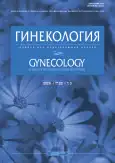The tactics of managing children and adolescents when twisting the uterine appendages from the position of international standards
- Authors: Batyrova Z.K.1, Kumykova Z.K.1, Uvarova E.V.1, Chuprynin V.D.1, Buralkina N.A.1, Kiseleva I.A.1, Mamedova F.S.1, Chundokova M.A.2,3
-
Affiliations:
- Kulakov National Medical Research Center for Obstetrics, Gynecology and Perinatology
- Pirogov Russian National Research Medical University
- Filatov Children’s City Clinical Hospital №13
- Issue: Vol 22, No 3 (2020)
- Pages: 39-41
- Section: ORIGINAL ARTICLE
- URL: https://bakhtiniada.ru/2079-5831/article/view/34979
- DOI: https://doi.org/10.26442/20795696.2020.3.200148
- ID: 34979
Cite item
Full Text
Abstract
Background. Adnexal torsion (AT) takes fifth place among all emergency gynecological conditions. Suspicion of AT requires immediate diagnosis and urgent surgical treatment. The most common causes of AT are various volumetric formations, such as functional or dermoid ovarian cysts, contributing to an increase in its volume and/or anomalies in the development of the ligamentous apparatus. Timely diagnosis and detorsion contributes to the full restoration of impaired venous outflow and lymphatic drainage of the ovarian tissue, preventing the development of severe ischemia and necrosis. Over the past few decades, a surgical organ-preserving approach in managing patients with AT has been the “gold standard” of care.
Materials and methods. The article describes the results of a retrospective study of cases of AT in children and adolescents treated at the Department of Pediatric and adolescent gynecology Kulakov National Medical Research Center for Obstetrics, Gynecology and Perinatology with an assessment of the clinical and anamnestic features of this cohort of patients and the choice of therapeutic tactics.
Conclusion. A multidisciplinary approach is critical to optimizing the delivery of care in cases of AT, including minimally invasive detorsion and preserving the functionality of the ovary as a treatment standard that should be used in the management of children and adolescents.
Keywords
Full Text
##article.viewOnOriginalSite##About the authors
Zalina K. Batyrova
Kulakov National Medical Research Center for Obstetrics, Gynecology and Perinatology
Author for correspondence.
Email: linadoctor@mail.ru
ORCID iD: 0000-0003-4997-6090
канд. мед. наук, ст. науч. сотр. 2-го гинекологического отд-ния (гинекологии детского и юношеского возраста)
Russian Federation, MoscowZaira K. Kumykova
Kulakov National Medical Research Center for Obstetrics, Gynecology and Perinatology
Email: zai-kumykova@yandex.ru
ORCID iD: 0000-0001-7511-1432
канд. мед. наук, ст. науч. сотр. 2-го гинекологического отд-ния (гинекологии детского и юношеского возраста)
Russian Federation, MoscowElena V. Uvarova
Kulakov National Medical Research Center for Obstetrics, Gynecology and Perinatology
Email: elena-uvarova@yandex.ru
ORCID iD: 0000-0002-3105-5640
чл.-кор. РАН, д-р мед. наук, проф., зав. 2-м гинекологическим отд-нием (гинекологии детского и юношеского возраста)
Russian Federation, MoscowVladimir D. Chuprynin
Kulakov National Medical Research Center for Obstetrics, Gynecology and Perinatology
Email: v_chuprynin@oparina4.ru
канд. мед. наук, зав. хирургическим отд-нием
Russian Federation, MoscowNatalya A. Buralkina
Kulakov National Medical Research Center for Obstetrics, Gynecology and Perinatology
Email: n_buralkina@oparina4.ru
ORCID iD: 0000-0001-5109-6725
д-р мед. наук, зав. приемным отд-нием, ст. науч. сотр. хирургического отд-ния
Russian Federation, MoscowIrina A. Kiseleva
Kulakov National Medical Research Center for Obstetrics, Gynecology and Perinatology
Email: i_kiseleva@oparina4.ru
канд. мед. наук, зав. по клинической работе 2-го гинекологического отд-ния
Russian Federation, MoscowFatima Sh. Mamedova
Kulakov National Medical Research Center for Obstetrics, Gynecology and Perinatology
Email: fmamedova@yandex.ru
канд. мед. наук, врач ультразвуковой диагностики отд. ультразвуковой диагностики в неонатологии и педиатрии
Russian Federation, MoscowMadina A. Chundokova
Pirogov Russian National Research Medical University; Filatov Children’s City Clinical Hospital №13
Email: cmadina@yandex.ru
D. Sci. (Med.), Prof.
Russian Federation, MoscowReferences
- Childress KJ, Dietrich JE. Pediatric Ovarian Torsion. Surg Clin North Am 2017; 97 (1): 209–21. doi: 10.1016/j.suc.2016.08.008
- Ripatti L, Taskinen M, Koivusalo A, Taskinen S. Surgically treated ovarian lesions in preadolescent girls. Acta Obstet Gynecol Scand 2019. doi: 10.1111/aogs.13717
- Geimanaite L, Trainavicius K. Pediatric ovarian torsion: Follow- up after preservation of ovarian tissue. J Pediatr Surg 2019; 54 (7): 1453–6. doi: 10.1016/j.jpedsurg.2019.02.004
- Muralidharan CG, Krishna S, Jose T. Pediatric ovarian torsion: a diagnostic challenge. Radiol Bras 2018; 51 (4): 274–5. doi: 10.1590/0100-3984.2016.0227
- Adnexal Torsion in Adolescents: ACOG Committee Opinion No, 783. Obstet Gynecol 2019; 134 (2): e56–e63. doi: 10.1097/AOG.0000000000003373
Supplementary files







